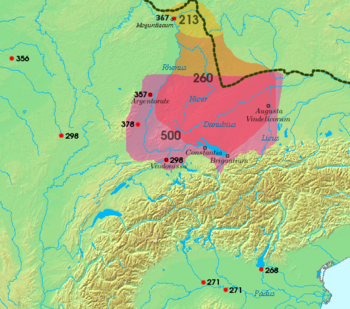
Back Alemanne Afrikaans Alemannen ALS Alamans AN ألامانيون Arabic الالامان ARZ Alemanlar Azerbaijani Алеманы Byelorussian Алемани Bulgarian Alemanned Breton Alemani BS

The Alemanni or Alamanni[1][2] were a confederation of Germanic tribes[3] on the Upper Rhine River during the first millennium. First mentioned by Cassius Dio in the context of the campaign of Roman emperor Caracalla of 213, the Alemanni captured the Agri Decumates in 260, and later expanded into present-day Alsace and northern Switzerland, leading to the establishment of the Old High German language in those regions, which by the eighth century were collectively referred to as Alamannia.[4]
In 496, the Alemanni were conquered by the Frankish leader Clovis and incorporated into his dominions. Mentioned as still pagan allies of the Christian Franks, the Alemanni were gradually Christianized during the seventh century. The Lex Alamannorum is a record of their customary law during this period. Until the eighth century, Frankish suzerainty over Alemannia was mostly nominal. After an uprising by Theudebald, Duke of Alamannia, however, Carloman executed the Alamannic nobility and installed Frankish dukes.
During the later and weaker years of the Carolingian Empire, the Alemannic counts became almost independent, and a struggle for supremacy took place between them and the Bishopric of Constance. The chief family in Alamannia was that of the counts of Raetia Curiensis, who were sometimes called margraves, and one of whom, Burchard II, established the Duchy of Swabia, which was recognized by Henry the Fowler in 919 and became a stem duchy of the Holy Roman Empire.
The area settled by the Alemanni corresponds roughly to the area where Alemannic German dialects remain spoken, including German Swabia and Baden, French Alsace, German-speaking Switzerland, Liechtenstein and Austrian Vorarlberg. The French-language name of Germany, Allemagne, is derived from their name, from Old French aleman(t),[5] and from French was loaned into a number of other languages, including Middle English, which commonly used the term Almains for Germans.[6][7] Likewise, the Arabic name for Germany is ألمانيا (Almania), the Turkish is Almanya, the Spanish is Alemania, the Portuguese is Alemanha, the Welsh is Yr Almaen and the Persian is آلمان (Alman).
- ^ The spelling with "e" is used in Encyc. Brit. 9th. ed., (c. 1880), Everyman's Encyc. 1967, Everyman's Smaller Classical Dictionary, 1910. The current edition of Britannica spells with "e", as does Columbia and Edward Gibbon, Vol. 3, Chapter XXXVIII. The Latinized spelling with a is current in older literature (so in the 1911 Britannica), but remains in use e.g. in Wood (2003), Drinkwater (2007).
- ^ The Alemanni were alternatively known as Suebi from about the fifth century, and that name became prevalent in the high medieval period, eponymous of the Duchy of Swabia. The name is taken from that of the Suebi mentioned by Julius Caesar, and although these older Suebi did likely contribute to the ethnogenesis of the Alemanni, there is no direct connection to the contemporary Kingdom of the Suebi in Galicia.
- ^
- Drinkwater, John Frederick (2012). "Alamanni". In Hornblower, Simon; Spawforth, Antony; Eidinow, Esther (eds.). The Oxford Classical Dictionary (4 ed.). Oxford University Press. ISBN 978-0191735257. Retrieved January 26, 2020.
Alamanni (Alemanni), a loose concentration of Germanic communities...
- Hitchner, R. Bruce (2005). "Goths". In Kazhdan, Alexander P. (ed.). The Oxford Dictionary of Byzantium. Oxford University Press. ISBN 978-0195187922. Retrieved January 26, 2020.
Alemanni... the Latin term for an amalgamation of a number of smaller Germanic tribes, including a segment of the Suevi.
- Darvill, Timothy, ed. (2009). "Alamanni". The Concise Oxford Dictionary of Archaeology (3 ed.). Oxford University Press. ISBN 978-0191727139. Retrieved January 25, 2020.
Alamanni. A confederation of several Germanic tribes who amalgamated in the third century AD
- Drinkwater, John Frederick (2012). "Alamanni". In Hornblower, Simon; Spawforth, Antony; Eidinow, Esther (eds.). The Oxford Classical Dictionary (4 ed.). Oxford University Press. ISBN 978-0191735257. Retrieved January 26, 2020.
- ^ in pago Almanniae 762, in pago Alemannorum 797, urbs Constantia in ducatu Alemanniae 797; in ducatu Alemannico, in pago Linzgowe 873. From the ninth century, Alamannia is increasingly used of the Alsace specifically, while the Alamannic territory in general is increasingly called Suebia; by the 12th century, the name Suebia had mostly replaced Alamannia. S. Hirzel, Forschungen zur Deutschen Landeskunde 6 (1888), p. 299.
- ^ recorded as aleman in c. 1100, and with final dental, alemant or alemand, from c. 1160. Trésor de la Langue Française informatisé s.v. allemand.
- ^ F.C. and J. Rivington, T. Payne, Wilkie and Robinson: The Chronicle of Iohn Hardyng, 1812, p. 99.
- ^ H. Kurath: Middle English Dictionary, part 14, University of Michigan Press, 1952, 1345.
© MMXXIII Rich X Search. We shall prevail. All rights reserved. Rich X Search